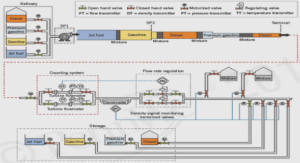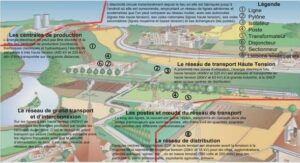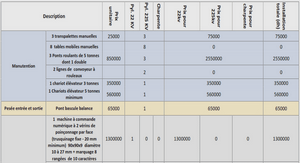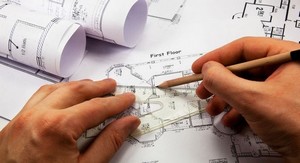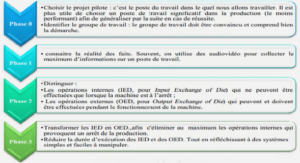Cours Choice Criteria for Stakeholders in the Province of Quebec, tutoriel & guide de travaux pratiques en pdf.
Literature Review
Cladding in non-residential construction
The cladding is the outermost layer of the envelope of a wall enclosing a building. It is the most visible part of a building and the most exposed to weather. The main function of cladding is to shelter from the elements. It protects the layers behind from weather elements. As a decorative function, cladding determines the building’s aesthetics effect. Typically, the cladding is a non-loadbearing component. The cladding is designed to support its own weight, withstand temperature variations and support loads of wind, snow, and impacts. It is usually used in conjunction with a structural frame for the load transfer (Gorse et al., 2012). In North America, commonly used cladding materials to construct the facades of non-residential buildings are stone, materials with mineral binders such as precast concrete, ceramic materials, glass, metals, timber, synthetic materials, render/plaster, cladding bent in mortar and thermal insulation composite systems (Hegger et al., 2006). Each group has different sub-categories with different characteristics. Therefore, the specifications and constraints of each project must be well analyzed and understood by the decision makers in order to meet client’s objectives.
It is important to distinguish the single household market from the non-residential market. Non-residential buildings include buildings designed for commercial, industrial and institutional purpose. In building codes, large residential buildings are mostly treated like non-residential buildings, and as such can be included as part of the investigation. This study focus on non-residential buildings since they are considerably different from residential buildings in terms of building size, materials, specifications, design and cost (O’Connor et al., 2003) From the manufacturer’s point of view, non-residential construction has a important economic potential as its value typically equates the residential market and tends to be less cyclical than the housing market (Kozak and Cohen 1999; O’Connor et al., 2004). Moreover, the non-residential market is strongly increasing due to densification of urban centers (FPAC, 2013; UNESCO, 2010).
Supply network and Process
The supply chain of cladding includes the client, the architect, the general contractor, the subcontractors, the distributor, and the manufacturer (Figure 2-1). Because of its high complexity, this supply chain would be better described as a supply network (Ledbetter, 2003). The nature of exchanges between stakeholders involves topics such as information, costs, production, services, and value (Du, 2009). The traditional mode, also known as design-bid-build, is the most common method in the Province of Quebec. There are possible variations of the traditional model for delivery method and manufacturer structure (Figure 2-1). The traditional model relies on fixed contracts. First, the client awards the contract to professionals (architects and engineers) for the design stage. Then, the client awards the second contract to the general contractor for the construction stage (For reading clarity, the term “contractor” will be used).
Stakeholders have well defined roles in non-residential building projects. The client is generally is the one who sponsors the real estate project. There are two types of clients: public and private. Architects are the main decision-makers for the prescription of nonstructural materials in non-residential buildings (Garmston et al., 2012). The contractor’s major role is to plan, coordinate and supervise the work of the subcontractor. Then, the subcontractor purchases the cladding system from a distributor and installs it. Usually, the distributor is different from the manufacturer. The distributor can be a general building materials distributor such as a hardware store or a cladding specialized distributor. Fully integrated manufacturer companies are only encountered in large and expensive contracts (Ledbetter, 2003).
Figure 2-1 Supply networks for exterior cladding and possible modifications for project delivery method and manufacturing structure (adapted from Royal Architectural Institute of Canada (2009))
Material Selection Criteria
A non-exhaustive literature review revealed different strategies for the characterization of the main choice criteria for cladding materials. Major databases in construction sciences (Compendex, ScienceDirect, Web of sciences) were searched using specific keywords (decision-making, material selection, building, façade, cladding, siding, criteria, and issues). Because of their accurate description of very important building construction selection criteria, seven documents were considered major and relative to the subject under study. The studies, summarized in Table 2-1, were analyzed according to the four dimensions: the domain, the object, the subject and the results. This method for analyzing literature content was inspired by Kassem and Mitchell study (2015). The domains are the type of building analyzed. It can be general buildings, single-home residential buildings or non-residential buildings. The object can be as general as the material, or be specific to the facade function or even more and related to the exterior cladding. Finally, the subject refers to the actors involved in the study. Studies generally focused on architects since they are the main specifiers of materials in a construction project. Other subjects included contractors, specialist subcontractors, client, and engineer. The analysis of three dimensions showed a lack of scientific knowledge for the exterior cladding material specifically in the non-residential construction. Table 2-1 also highlights other studies consider the whole value network (client, architect, contractor, and subcontractor).
The fourth dimensions of this analysis, the results, are presented in Table 2-2. For each study, results differ by type of criteria analyzed. The results are categorized in three criteria: selection, decision, or influence. There is no consensus on the term to use to define such a problematic. Table 2-2 also highlighted two reccuring choice criteria: appearance and past experience with the product.
Method
To find relevant and effective solutions to the diversity of problems observed and cited in the research questions, this study draws on the strengths of the instrumental collection of quantitative and qualitative research. This method allows a more exhaustive and differentiated knowledge of an observed phenomenon and problems herein. This mixed research method consisted of an online survey and semi-directed interviews (Amaratunga et al., 2002). Chronologically, the online survey preceded the semi-structured interviews. It was a process, aiming to gradually deepen the subject under study.
This study focuses on stakeholders from an East North American context (Province of Quebec, Canada). The information gathered is based on a demanding northern climate caracterized by a mix of cold and very cold climate zones(ASHRAE, 2007). Although the results of this study are of greatest interest for North American they are also valuable for stakeholders in similar contexts.
Online Survey
Architects are the main specifier in the selection of a cladding material in non-residential construction. To better understand their principal choice criteria, an online survey was conducted. The online survey was selected as a first data collection method because it provides preliminary information quickly and inexpensively. The survey revealed that choice criteria were related to influence, requirement, and appearance during the cladding selection process. These results served as a basis for the development of the semi-structured interviews.
Method
To better identify important research themes and accurately represent stakeholder opinion, a high response rate was necessary. To maximize the response rate of the survey, the survey was designed according to Dillman’s method (Dillman et al., 2014). Filling the survey was simple and required little time (approx. 10 min.) for the respondents. The questionnaire was devised in three parts. The first part collected information such as the profession and the region in which they practice in order to characterize the sampling. The second part aimed to understand the importance given by the respondents to different influence, requirement, and appearance criteria. Finally, the third part was open-ended and asked the architects to identify reasonable expectations for the long-term durability and the maintenance cycle of exterior cladding material in non-residential buildings. The questionnaire was tested with an architect and an external research manager in business intelligence to ensure the criteria and questions were clear and relevant. To measure and understand the opinion of architects, multiple-choice questions were based on a balanced Likert gradient scale (i.e. 1 = not important, 2 = somewhat, 3 = average, 4 = very and 5 = extremely important). A free online-software (Lime Service) was used to conduct the survey. The architects were joined using a mailing list of the Ordre des architectes du Québec (OAQ). An Internet link was included in the bi-weekly newsletter sent to 3621 architects. Participation in the online survey was based on willingness. The voluntary participation induced the assumption that the respondents were concerned with the research question.
Results were analyzed using IBM Statistical Package for the Social Sciences (SPSS) Statistic 24 software program (International Business Machines Corporation, USA). The study selected the severity index analysis (SI) to rank the criteria for each category. The non-parametric procedure is more suitable than parametric statistics (mean, standard deviation, etc.) to rank the criteria and produce meaningful results (Chen et al., 2010; Johnson and Bhattacharyya, 1996.; Singhaputtangkul et al., 2014). Equation 1 was used to calculate de SI value for each criterion.
Where i = point given to each criterion by the respondent, ranging from 1 to 5; ωi = weight of each point; fi = frequency of the point i by all respondents; n = total number of responses (n = 67 in this study); and a highest weight (a = 5 in this study). Chen et al. (2010) use the calculated SI value to categorize the criteria into five importance levels: High (H) (0.8 ≤ SI ≤ 1), High–Medium (H–M) (0.6 ≤ SI < 0.8), Medium (M) (0.4 ≤ SI < 0.6), Medium–Low (M–L) (0.2 ≤ SI < 0.4), and Low (L) (0 ≤ SI < 0.2).
Results
Sixty-seven architects completed the online survey. The response rate (1.72%) was not consistent with the literature (Akadiri and Olomolaiye, 2012; Damery and Fisette, 2001; Singhaputtangkul et al., 2014) but the number of respondents is still higher than in some studies (Damery and Fisette, 2001; Kassem and Mitchell, 2015; Singhaputtangkul et al., 2014). Moreover, the number of architects contacted represents the entire population of architects in the Province of Quebec. The aim of the survey was not to create a statistical database but rather provides insight into choice criteria. Table 2-3 shows the general characteristics of the respondents. As shown in Table 4, the online survey identified the product’s reputation and architect’s personal experience as being the most important influencing criteria. Online survey results also show that municipal regulation is the third most considered influencing criterion tied to the client choice. Results also revealed that architect’s three most important requirement in the choice of a cladding material are performance, appearance, and warranty. Conversely, the environmental footprint is the least important criterion. About performance, Erreur ! Source du renvoi introuvable. results ndicated on average a 40-year long-term durability and a 14-year maintenance cycle as reasonable expectations. Appearance is the second most important need. Appearance is a priority and serves the interest of the overall concept. The durability over time of the appearance is the most important concept. Another important aspect of the appearance is the fit with the other materials.
